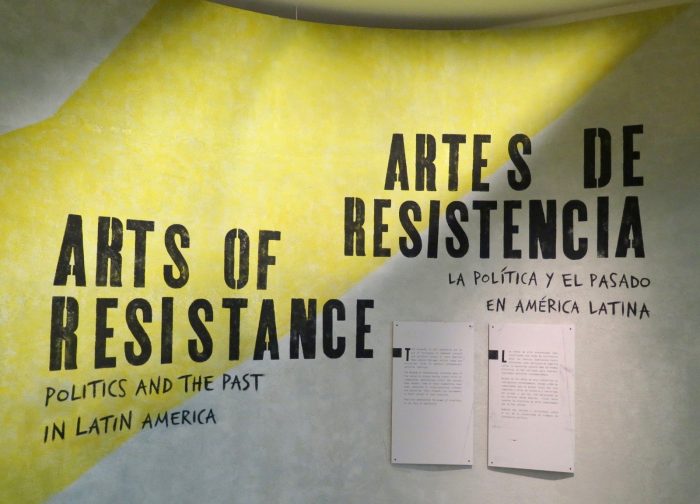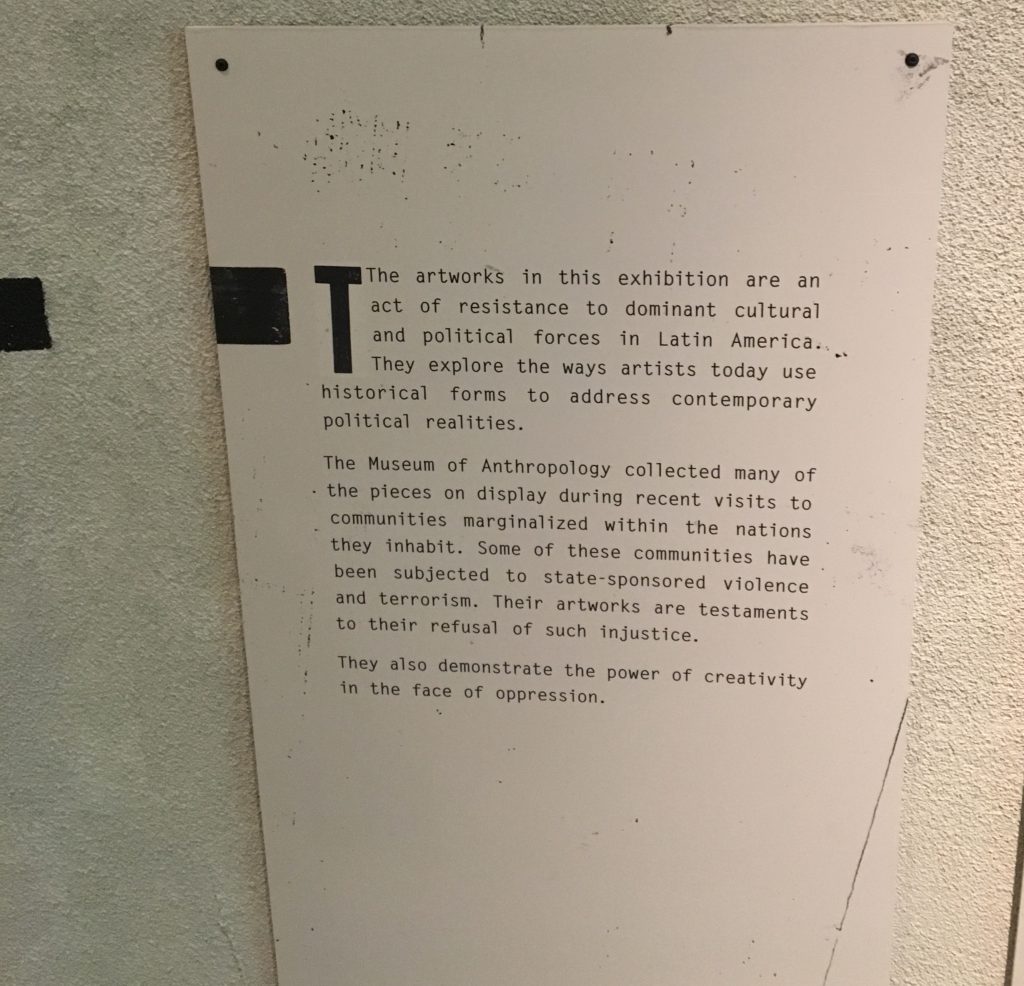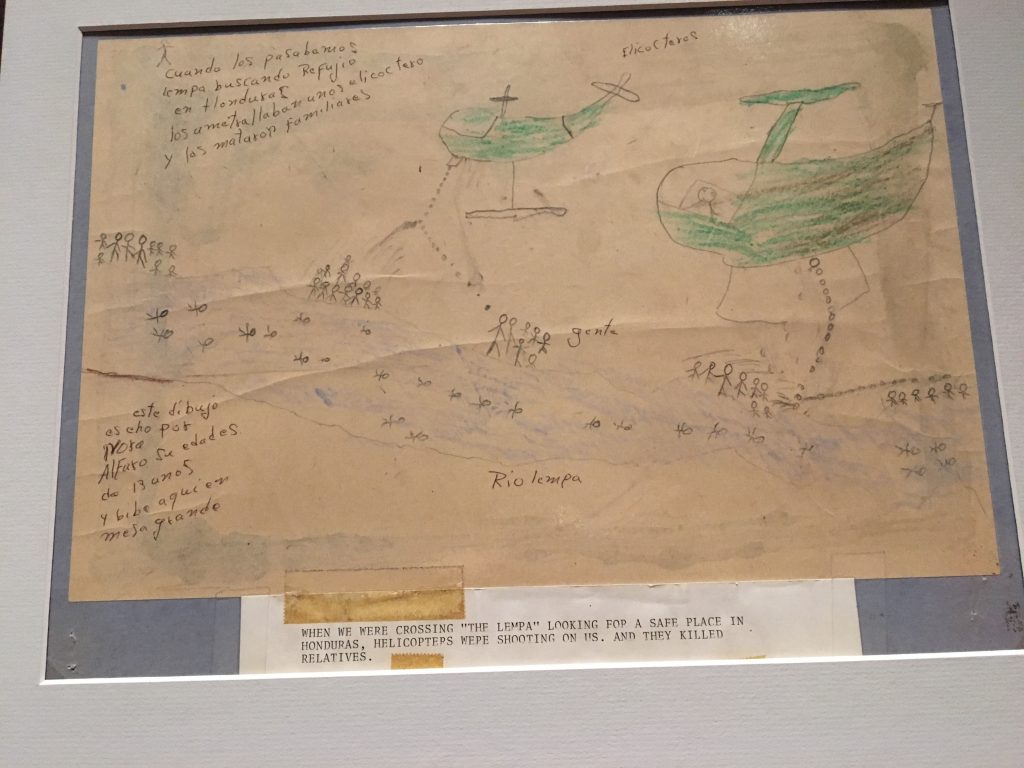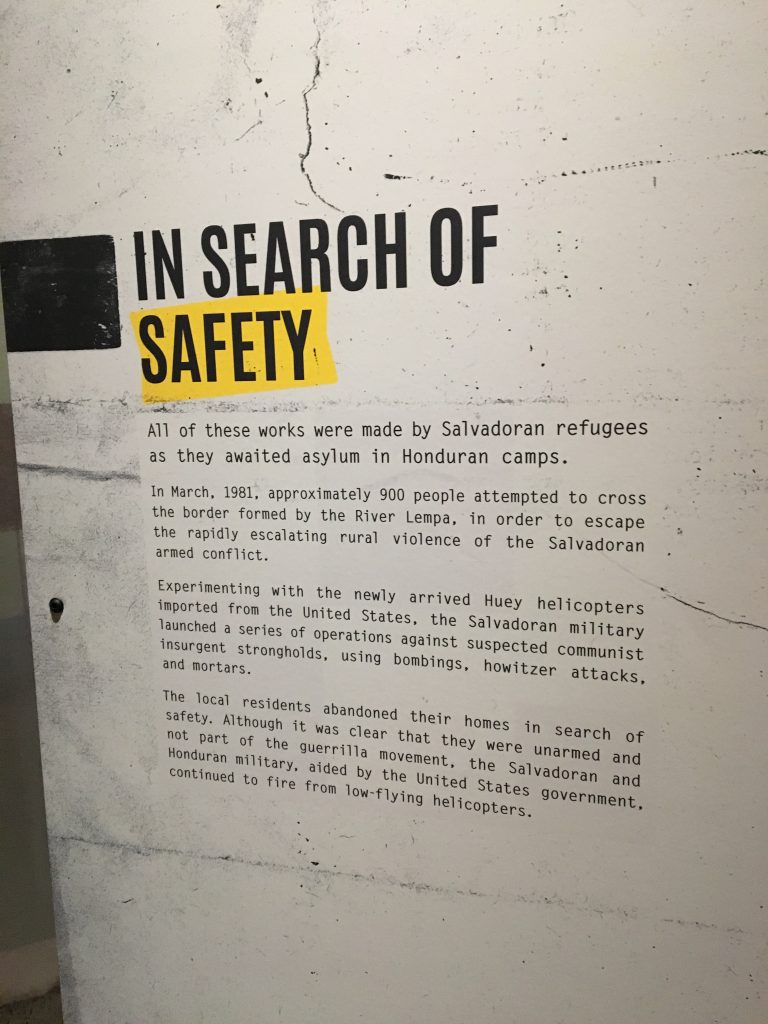
The Museum of Anthropology at UBC is designed to tell us stories through objects of history. In the Museum, I had the chance to see an interesting exhibition called the “Arts of Resistance: Politics and the Past in Latin America, ” which was curated by Dr. Laura Osorio Sunnucks. This exhibition was designed to give everyone an inside look into how “traditional or historical arts forms” can be used to express political and social struggles people have faced and are facing in marginalized communities. This exhibition shows global arts and performance of artists from Mexico, Peru, Guatemala, El Salvador, Ecuador, and Chile.

I have been to museums a couple of times during my childhood, and I did not fully understand the stories behind the art. I saw the art but could not comprehend what the artists were trying to convey. As I have now matured, I now understand and can analyze the performance of art and see the hidden stories behind them. I believe that looking at art and searching for the hidden stories takes effort and is time consuming. The reason why everyone is so silent and fixated on the art is that they are trying to find the story. I have recently found this out when I visited the Arts of Resistance exhibition. The first time I went to see this exhibit, I was a bit lost and didn’t understand what the artists were trying to convey. I simply walked in, looked at the art and then left with a very confused mind. I spent about 20 minutes looking at the art and nodding my head thinking I understood what was around me, but simply I did not. I wanted to have a better understanding of the exhibition, and this enticed me to visit the exhibition for the second time. As I revisited the exhibition, I had a greater sense to really engage in the art and I was driven to find the stories in the different pieces of art. I took the time to really engage in the artwork and finally understood the stories of the objects around me. I found that all the pieces and performances in the exhibit drew to the theme of memory which was discussed in my ASTU class.

As I walked around the exhibit, the one object that really struck me, and shocked me was an art drawn from a child. In the art, it is shown the green helicopters who were the Salvadoran military were shooting on the Salvadoran refugees, as they were only trying to find a home in the Houndras by crossing the River Lempa. In the artwork, there appears to be around 70 people trying to escape in search for safety. Some refugees are seen in groups trying to escape and getting shot at. Whereas, other refugees are seen swimming in the water trying to escape from gun shots and reach safety.

The child’s memory of the event was one version of the truth. In his/her eyes, I saw what he/she saw and experienced. This made me realize that we all have different childhoods and those memories can stick with us forever. This makes a global connection towards the different stories and experiences everyone has. During those times, someone’s childhood was based on experiencing the act of violence and loss of family and relatives. Whereas, in another part of the world, someone’s childhood was filled with laughter, fun, and joy.
In my ASTU class, we talked about questions like “can this individual memory tie with the collective memory and how it affects the memory of the group ?” This got me wondering if this child’s memory is presumed as the sole “truth?” Also, can this individual memory tie with the collective memory of all the children refugees at the time?” The documemoir, “Stories We Tell,” by Sarah Polley shows the different perceptions of truth told by Sarah’s family members and friends which tries to unveil Sarah’s identity. The film highlights how memory affects how people tell their stories. The art above, is one perception of the truth and unveils a certain piece of the Salvadoran refugees’ identities. The art was drawn out of memory of violence and how that can twist the truth by exaggerating or underestimating the violence to better oneself. Violence in a child’s memory can be totally different from an adult’s mind. The explosions and the gun shots may sound more alarming and tremendous. Underestimating the situation and filtering out the violent part of the memory might happen to better the child’s childhood. The child’s memory of what happened when everyone was trying to escape can be different from another child’s perspective as well. As the audience, we have to interpret the truth from the art.
In the view of a sociological perspective, this artwork connects with the idea of the sociological imagination. The sociological imagination shapes our experiences using external factors. This connects a link between personal troubles and public issues. An example of personal troubles can be discrimination in the workplace which is a huge public issue now days. This personal trouble of experiencing trauma and violence can make people connect with others who have experienced this as well. This makes refugees see that others have experienced the same and that it is not a personal trouble but a public issue. However, a child might not have this sociological imagination by connecting with others through this experience because it is unsettling and very traumatic. Also, the time to reflect on the situation and talk to others is minimal due to the constant worry of finding safety. This made me think about how refugees might not have the time to reflect back on their experience as they might be worried about their safety and wellbeing.
This exhibition was an eye opener for me about the world around me, and how everyone’s experiences are so unique. I realized that memory plays a very important role in recalling the past and how it can be and not be the truth. At first, I was really confused about the exhibit, but after my second visit, I truly connected with some of the pieces of art. The child’s artwork was really outstanding, and it made me understand that not everyone has a great childhood. I felt very distraught and emotional thinking about what children had to truly experience in their early years of childhood. I still wonder, in the exhibition, how does the memories of the people affect the work of the artist? How does the artists take the truth and the memory to really paint the picture?
https://creatorsvancouver.com/latin-american-resistance-art/